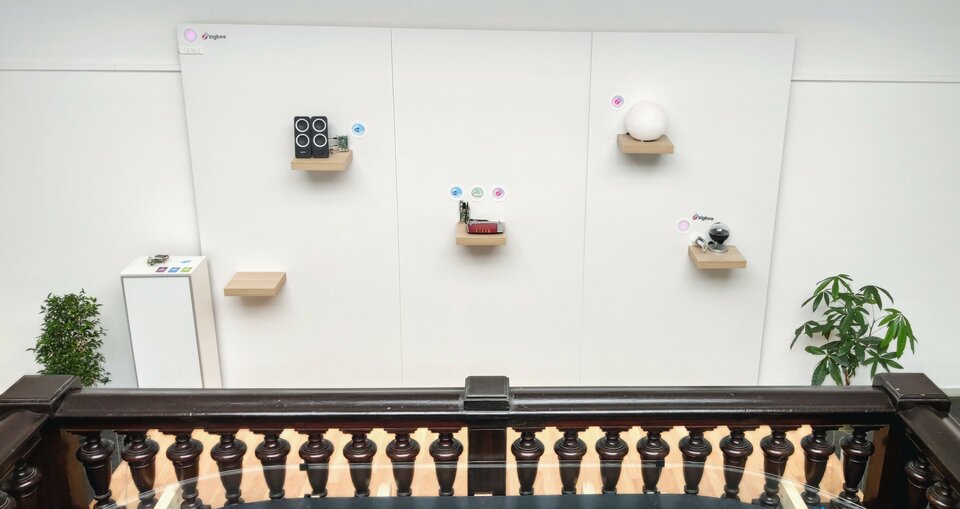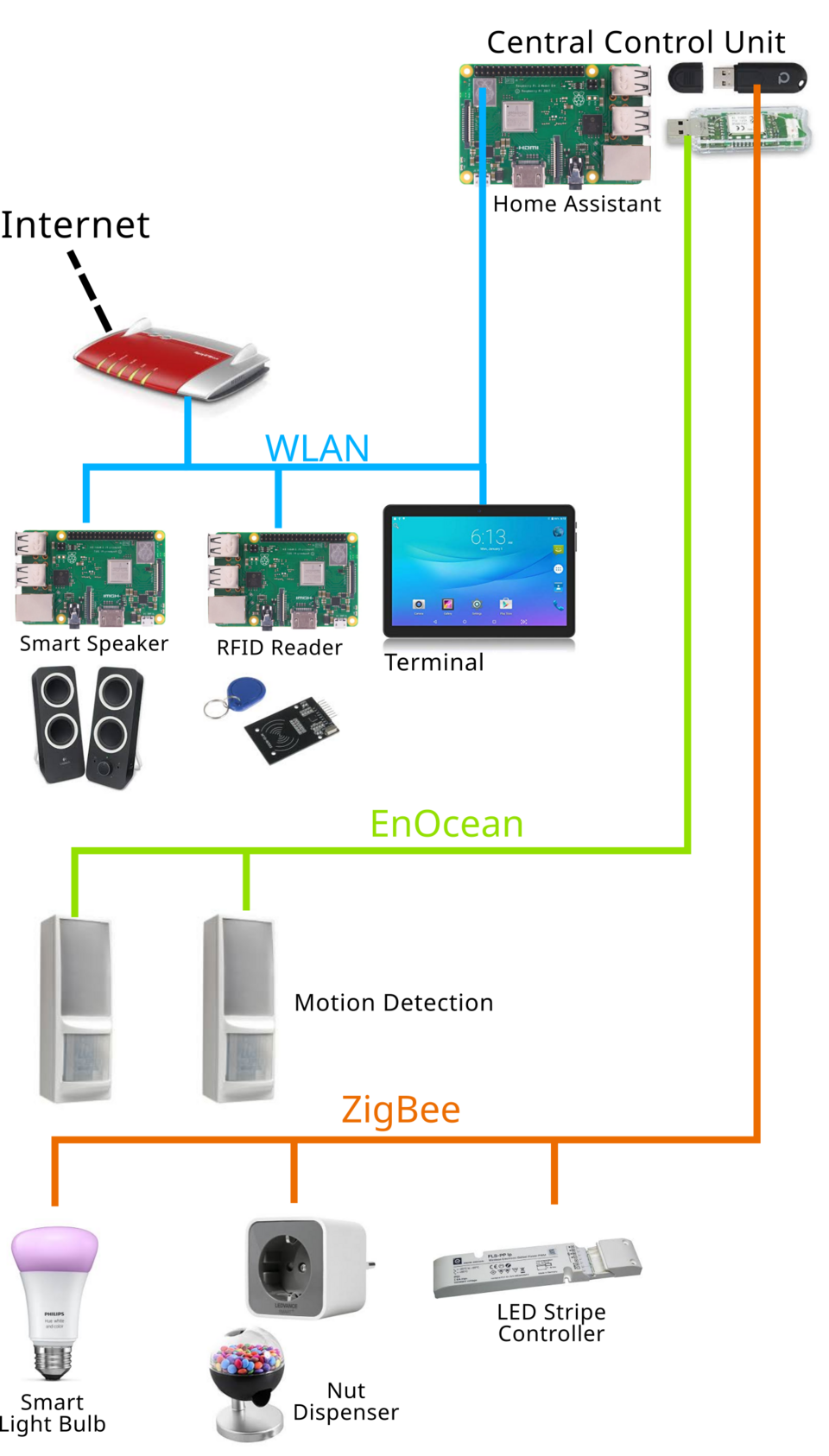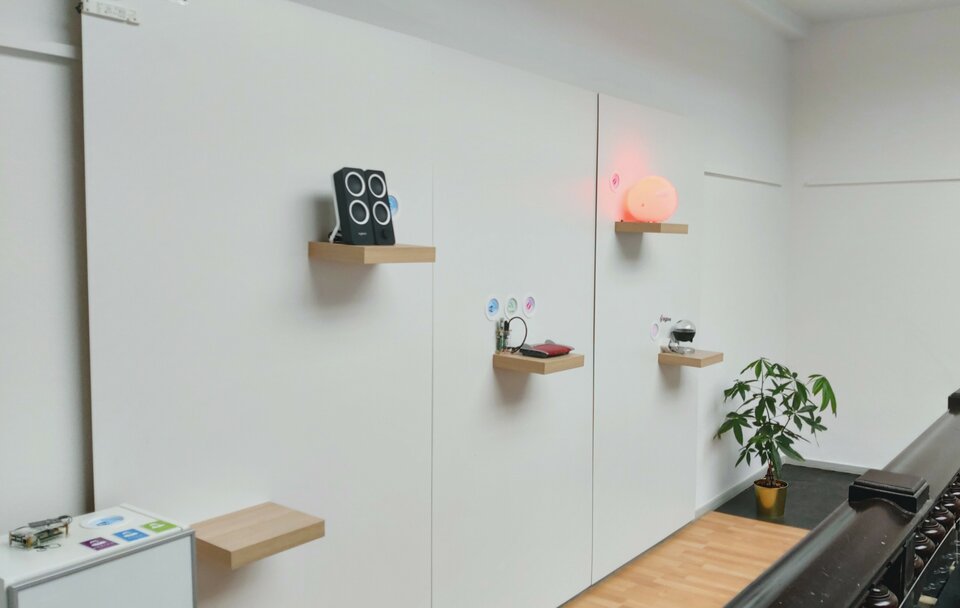Smart Home Testbed Platform

- IoT devices for SmartHomes gain a lot of attention in recent years. From smart speakers from Amazon and Google to smart windows, fridges, lights, etc. They use their own communication technology (Wifi, Bluetooth, ZigBee, ...) and their own protocols to integrate in your smart home.
- There are many open questions in that regard. Security, privacy, resourcefulness, lifecycle management, etc. Two questions we focused on were
- What wireless communication technologies are currently available and what are their benefits, shortcomings and limitations?
- Is it possible to integrate products from multiple vendors using different communication technologies into ONE network/SmartHome system? And how?
Available Technologies
When deciding on a certain brand from an IoT vendor, they usually settled on using one or two different communication technologies. We focused on the wireless transmission, as there are solutions with many different characteristics. This is usually power consumption, robustness against interference, achievable data rate, latency, network scaling and others. Since each application has its own communication requirement and the environments may differ, no technology fits them all. For that reason we researched about available techs, their properties as well as where and how they are embedded in various products.

Integration
Now, with that knowledge, we selected a) widely available and used (ZigBee) b) promising and interesting (EnOcean) communication solutions as well as DIY self build ones. We also looked into integrating those into one system.
Central Control
A modern smart home system usually consists of multiple sensors, actuators, a gateway for internet connectivity and a single central control unit (CCU). The CCU is responsible for automations and control. We found, that there are commercial solutions available and they shared some common properties.
1. They all run in the cloud.
2. They cost a subscription fee.
This setup offers easy and quick installation without upgrade issues. But that convenience comes at a cost. Your smart home will just stop working if you loose internet connectivity, the provider goes offline or you stop paying a monthly subscription. Additionally you put your faith in their safekeeping of the infrastructure, which is centrally controlling several, if not thousands of homes.
As an alternative, we selected an open source solutions which is deployed locally and under our control. Numerous solutions for the CCU are available with OpenHAB, Domoticz and HomeAssistant being the most prominent. This approach has some advantages, e.g.
1. The (private) data stays local.
2. The system works even without internet connectivity
3. No monthly subcsription costs.
We decided to try out HomeAssistant.
1. We installed home assistant on a Raspberry Pi and extended it with wireless modules for the wireless SmartHome technologies "ZigBee" & "EnOcean". It was also connected to a local WLAN network.
2. We bought devices using ZigBee & EnOcean and connected them to HomeAssistant using these wireless modules. From that moment on, all devices have been integrated into the control unit.
3. Now, we tested this by implemeting some example scenarios which are.
- Access Control - Only one person can access a nut dispenser after idenfying himslf.
- Light Control - Depending on the person who identified on the entrance, the wall will respond with custom colors and lights
- Alarm - the wall detects movement and will sound an alarm if no person has identified himself.
Conclusion
The most important lesson learned is that successful IoT Systems must integrate with each other. We showed that with very different IoT devices, in a System of Systems, real use-cases can be created using different wireless technologies and products from different vendors by integrating them with open source solutions.
Outlook
In the future we could expand on that idea of smart technology integration.
1. Voice control - status feedback via voice, control actions via voice
2. Private video surveillance - see who has ben doing what when, smart deleting or notifying ("an unknown person entered...")
3. Robots like vacuum cleaners - smart home controls robot by activating it only when nobody is around
Many more scenarios and technologies are available and it would be interesting to see whats possible to integrate and what use-cases become available.

FAQ
What is the purpose of this wall?
This wall shows, that different SmartHome devices with diverse wireless technologies can be integrated into one joint SmartHome network. Moreover, it proves that realizing automations is possible using locally deployed open source software and without using the cloud.
What does SmartHome mean?
A SmartHome is an intelligent, connected system comprising actuators, sensors and control. Actuators are things like lights, speakers, garage motors and any device that can do or execute something. Instead, sensors measure and observe, for example motion detectors, thermometers or just buttons and switches. The control is the brain of the SmartHome and, based on the sensor readings, makes decisions for the actuators. This can for example be the control of an actuator or just sending a message to the owner. For example, a message could be a warning when water is detected below a left open kitchen window.
What do the colorful lights signify?
Next to each IoT SmartHome Device these is a round light embedded in the wall. Its color and icon describe, which wireless technology is employed by the device. Blue means WiFi, pink relates to ZigBee and green denotes EnOcean. A blinking light indicates that the respective IoT device is currently communicating.
What does the wall do?
This is to be found out. You can interact with the wall by approaching it and putting different User ID cards onto the card reader. The wall will react accordingly.
Where is the control?
In contrast to a cloud-based control, this IoT SmartHome Wall is managed by a controller, which is as well located on the wall. It is mounted in the center and can communicate with all devices at the same time. So-to-speak, it masters 3 different languages. In the controller, all information is processed and decisions for actuators are made and communicated.
Why do different wireless technologies exist? Why should I use them jointly?
Different wireless technologies have different coverage, energy consumption and speeds. Often, there is a network and communication protocol on top, which allows devices to inter-connect to increase the coverage. Alternatively, the wireless technology can allow very long battery lifetime. Depending on the application, device and location, different technologies can be useful. By the same reason, smartphones are equipped with different wireless techonlogies, such as WiFi (local internet), Bluetooth (for e.g. headphones) and LTE (mobile internet).
Which benefit does integrating all SmartHome devices into one network bring?
In order to arrange meaningful automations, the SmartHome controller needs access to all devices. Usually, systems from different manufacturers cannot interact with each other out of the box. This is due to the fact that each manufacturer embeds their devices via a specific access point into the network, such that the devices can only be controlled via a special SmartPhone App. This access point can only communicate with the built-in wireless protocol, similar to your local WiFi router. For all other wireless technologies, it is blind.
Why without the cloud?
The cloud can only be reached via the internet. This means, a remote computer communicates with the IoT devices and controls them via the internet. In case the internet connection drops, the SmartHome will stop working. If the product is discontinued or the manufacturer becomes bankrupt the SmartHome again stops being "smart". This implies a large dependency to multiple external parties for a working SmartHome.
In addition, providers need to be strongly trusted, because being controlled from the internet means that your system has an open interface to the internet. This needs to be secured against possible attackers. Private data which is collected within a SmartHome shall be securely processed, saved and also deleted.
On the other hand, there are advantages of using the cloud. These are e.g. a simpler installation and maintenance. Since we at the Barkhausen Institute take a stand for security and privacy, only a locally controlled system without connection or dependence to the outside is acceptable.
Which wireless technologies are applied here?
For demonstration purposes, we connected devices which use the communication protocols WiFi, EnOcean and Zigbee. These can be identified via the WiFi, enocean and Z stickers.
What is EnOcean?
EnOcean is one of the three wireless technologies that are used for the wall's setup. It excels in low energy consumption, such that a small solar cell or the pressing of a doorhandle produces enough energy for one message. Using this technology, devices can be operated without a battery. The devices deployed by us are to motion detectors which are located at the opposite side of the wall.
What is ZigBee?
ZigBee is one of the three wireless technologies that are used for the wall's setup. It can be characterized by a moderate energy consumption. Moreover, devices can communicate with each other and forward messages. This way, the coverage of the network grows with the number of the devices. These days, this technology is applied by many products, for examples by IKEA smart lights or Philips Hue. Amazon Alexa speaks ZigBee as well and hence can directly control these devices. Within our setup, the lamp, the LED strip on the top of the wall and the power outlet use ZigBee.
What are plans for the future?
Currently, there are no direct plans for the future. But, we have several ideas:
1. Voice control - The wall could be controlled with verbal commands and interact with the user. At the same time, difficulties and problems with the authentication using the voice can be indicated.
2. Video Surveillance - Investigate, how private video surveillance can be integrated securely without breaching the privacy of third parties.
3. Robotic vacuum cleaner - Integrate and automatically control a vacuum cleaner without access from the internet.
